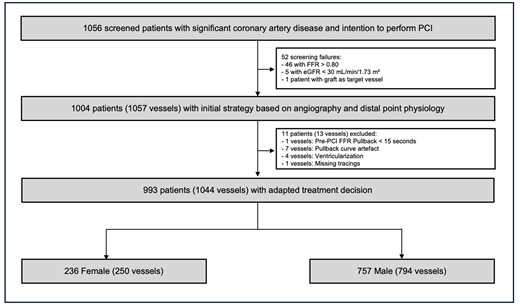-
PDF
- Split View
-
Views
-
Cite
Cite
S Brouwers, D Munhoz, T Storozhenko, K Sakai, K Arslani, T Engstrom, D Collison, L Desta, A Yong, J Adjedj, J Escaned, M Nakayama, C Berry, B De Bruyne, C Collet, PPG Global study team, Gender differences in coronary artery disease patterns, European Heart Journal, Volume 45, Issue Supplement_1, October 2024, ehae666.1401, https://doi.org/10.1093/eurheartj/ehae666.1401
Close - Share Icon Share
Abstract
Gender differences in clinical presentation, natural history, and prognosis of coronary artery disease (CAD) have been reported. Fractional flow reserve (FFR) has also been shown to yield higher values in women than men. However, the gender differences in CAD patterns (focal vs diffuse) defined by coronary physiology remain to be studied.
This prospective study was performed at 23 sites and enrolled patients with at least one epicardial lesion with an FFR ≤ 0.80 intended to be treated by PCI. All patients underwent a standardized physiological protocol that mandated FFR pullbacks with pullback pressure gradient (PPG) calculation. The aim was to compare CAD patterns, defined by PPG, between genders.
Overall, 1004 patients were included in the analysis, 236 females (250 vessels) and 768 males (794 vessels). Women were older (69.8 ± 10.3 vs. 67.0 ± 10.1, p <0.001), less frequently smokers (9.7% vs. 18.6%, p = 0.002), had less prior PCI in a non-target vessel (19.1% vs. 30.6%, p = 0.001) and had less prior MIs (14.4% vs. 21.5%, p = 0.021). On the baseline seven-item Seattle Angina Questionnaire (SAQ-7), females reported more physical limitation (70.9 ± 29.5 vs. 80.9 ± 25.1, p < 0.001), more frequent angina (76.7 ± 22.9 vs. 81.5 ± 20.3, p = 0.002) and a lower quality of life (51.8 ± 29.4 vs. 57.8 ± 29.1, p = 0.006) than men for the same degree of flow reduction (FFR 0.69 ± 0.12 vs. 0.67 ± 0.11, p=0.098). In women, the pattern of CAD demonstrated a more focal nature compared to men (PPG 0.65 ± 0.16 vs. 0.61 ± 0.16, p = 0.001). Also, women achieved higher post-PCI FFR (0.88 ± 0.07 vs. 0.87 ± 0.07, p = 0.02). The rate of periprocedural MI was not statistically different between genders (5.1% vs. 5.8%, p = 0.79)

Study flowchart

PRO and Phisiology by gender
Author notes
Funding Acknowledgements: Type of funding sources: Private grant(s) and/or Sponsorship. Main funding source(s): The study was sponsored by the244
Cardiovascular Research Institute (CRI) Aalst with an unrestricted grant from Abbott Vascular.



